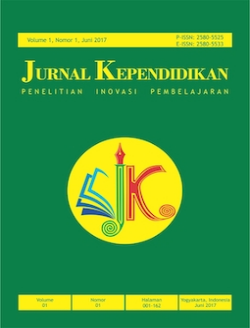Project-based Learning Model for strengthening Elementary students' creativity in Sciences
Downloads
Downloads
Ambiyar, et al. (2020). Penerapan Model Project-Based-Learning Dalam Mata Diklat Gambar Sketsa. Jurnal Kependidikan, 4(1), 125–138.
Audia, R., & Hidayat, H. (2023). Increasing Activities And Student Learning Outcomes With The Project-Based Learning Model In The Thematic Learning Theme Of Our Friends In Class V Sdn 101911 Sidodadi. Widyagogik : Jurnal Pendidikan Dan Pembelajaran Sekolah Dasar, 10(2). Https://Doi.Org/10.21107/Widyagogik.V10i2.18190
Baptist, K. J., D. N. Utami, B. Subali, S. A. (2020). Effectiveness Of Project Based Learning And 5e Learning Cycle Instructional Models. Jurnal Kependidikan, 4(1), 55–69.
Chang, C. H. S., Lin, F. L., Hsieh, C. J., & Chen, B. Y. (2023). The Challenges Of Students With Blindness And The Instructional Strategies Of Their Instructors In Mathematics Game-Based Learning. Journal Of Research In Education Sciences, 68(2). Https://Doi.Org/10.6209/Jories.202306_68(2).0002
Dewi, Y. A. S., Munawaroh, D. A., & Hayati, R. M. (2021). Metode Teacher Centered Learning (Tcl). Seminar Nasional Teknologi Pembelajaran, 1(1).
Fajaruddin, F. (2022). Penerapan Model Pembelajaran Berbasis Proyek (Project Based Learning) Terhadap Kemampuan Berpikir Kreatif Dan Hasil Belajar Siswa Kelas Xi Mipa-1 Pada Materi Gelombang Bunyi Dan Cahaya Di Sma Negeri 1 Glumpang Baro. Jurnal Sosial Humaniora Sigli, 5(1). Https://Doi.Org/10.47647/Jsh.V5i1.634
Farida, A., & S, N. A. (2022). Efektivitas Model Pembelajaran Project- Based Learning Pada Mata Kuliah Metode Numerik. Jurnal Litbang Provinsi Jawa Tengah, 20(1), 1–8.
Hafsah M. Nur, N. F. (2022). Paradigma Kompetensi Guru. Jurnal Pgsd Uniga, 1(1), 12–16.
Hidayati, S., & Restian, A. (2023). Peningkatan Kreativitas Menggunakan Model Project Based Learning Mata Pelajaran Ipas Konteks Merdeka Belajar Kelas 4 Sekolah Dasar. Pendas : Jurnal Ilmiah Pendidikan Dasar, 8(1). Https://Doi.Org/10.23969/Jp.V8i1.7860
Homayunhosseini, A. Z. (2023). An Intervention Design For Promoting Quality Of Life Among Patients With Multiple Sclerosis: A Protocol With A Planning Approach For A Mixed Methods Study. Bmc Neurology, 23(1). Https://Doi.Org/10.1186/S12883-023-03078-W
Ifit Novita Sari, D. (2022). Metode Penelitian Kualitatif. Unisma Press.
Junia, I., & Sujana, I. W. (2023). E-Modul Interaktif Berbasis Profil Pelajar Pancasila Pada Mata Pelajaran Ipas Materi Kekayaan Budaya Indonesia Bagi Siswa Kelas Iv Sd. Articles, 11(Pendidikan).
K. Perayani, I. W. R. (2021). Pembelajaran Keterampilan Menyimak Dengan Menggunakan Media Podcast Berbasis Model Pembelajaran Project Based Learning (Pjbl). Jurnal Pendidikan Dan Pembelajaran Bahasa Indonesia, 11(1), 108–117. Https://Ejournal2.Undiksha.Ac.Id/Index.Php/Jurnal_Bahasa/Article/View/695
Khasanah, I. (2023). Wali Kelas 4 Min Pekalongan, Wawancara Pribadi, Pekalongan, 5 Maret.
Kristansi, Y. D., Subiki, & Handayani, R. D. (2021). Model Pembelajaran Berbasis Proyek ( Project Based Learning ). International Journal Of Educational Resources, 5(2), 122–128.
Mulyati, S. (2023). Increasing Learning Achievement Of Class Iv Students In Social Subject About Nature's Appearance Of Using Interactive Learning Models. Eduvest - Journal Of Universal Studies, 3(4). Https://Doi.Org/10.59188/Eduvest.V3i4.785
Muslim, A. (2022). Landasan Filsafat Idealisme Dan Implementasi Kurikulum Merdeka Belajar. Jetish: Journal Of Education Technology Information Social Sciences And Health, 1(1), 34–40. Http://Rayyanjurnal.Com/Index.Php/Jetish/Article/View/35/39
Nurul Amelia, Shela Fahra Dilla, Siti Azizah, Zachra Fahira, A. D. (2023). Efektivitas Peran Guru Dalam Kurikulum Merdeka Belajar. Jurnal Ilmiah Wahana Pendidikan, 9(2), 421–426.
Sadikin, A., & Yelianti, U. (2021). Inovasi Pembelajaran Mata Kuliah Pembelajaran Mikro Berbasis Model Pjbl (Project Based Learning) Untuk Meningkatkan Kreativitas Mahasiswa. Biodik, 7(3). Https://Doi.Org/10.22437/Bio.V7i3.15709
Siti Ghaida Sri Afira Ruhyadi, Adi Abdurahman, M. B. (2022). Implementasi Model Project Based Learning (Pjbl) Dalam Penerapan Kurikulum Merdeka Belajar Di Kelas Tinggi Mi/Sd. Al-Ibanah, 7(2), 1–9. Https://Doi.Org/10.54801/Ibanah.V7i2.107
Situmorang, M., Sinaga, M., Sitorus, M., & Sudrajat, A. (2022). Implementation Of Project-Based Learning Innovation To Develop Students' Critical Thinking Skills As A Strategy To Achieve Analytical Chemistry Competencies. Indian Journal Of Pharmaceutical Education And Research, 56(1). Https://Doi.Org/10.5530/Ijper.56.1s.41
Thongsri, P., & Susilowati, Dan E. (2021). Analysis Dimensions Of Creativity In Stem Integrated Project Based Learning. Jurnal Kependidikan, 5(2), 237–249.
Wardah, I., Septaria, K., Mahbubah, K., & Mubarok, H. (2022). The Effect Of Project Based Learning (Pjbl) Model On Students' Science Literacy In Social Studies Subjects. Jurnal Penelitian Dan Pengkajian Ilmu Pendidikan: E-Saintika, 6(2). Https://Doi.Org/10.36312/Esaintika.V6i2.738
Yanti, R. A., & Novaliyosi, N. (2023). Systematic Literature Review: Model Pembelajaran Project Based Learning (Pjbl) Terhadap Skill Yang Dikembangkan Dalam Tingkatan Satuan Pendidikan. Jurnal Cendekia : Jurnal Pendidikan Matematika, 7(3), 2191–2207. Https://Doi.Org/10.31004/Cendekia.V7i3.2463
Yuristia, F., Hidayati, A., & Ratih, M. (2022). Pengembangan Modul Pembelajaran Ipa Berbasis Problem Based Learning Pada Pembelajaran Tematik Sekolah Dasar. Jurnal Basicedu, 6(2), 2400–2409. Https://Doi.Org/10.31004/Basicedu.V6i2.2393
The authors submitting a manuscript to this journal agree that, if accepted for publication, copyright publishing of the submission shall be assigned to JK. However, even though the journal asks for a copyright transfer, the authors retain (or are granted back) significant scholarly rights.
The copyright form should be signed originally and sent to the Editorial Office through email to jk@uny.ac.id
Download HERE

Jurnal Kependidikan by http://journal.uny.ac.id/index.php/jk is licensed under a Creative Commons Attribution-ShareAlike 4.0 International License.




























